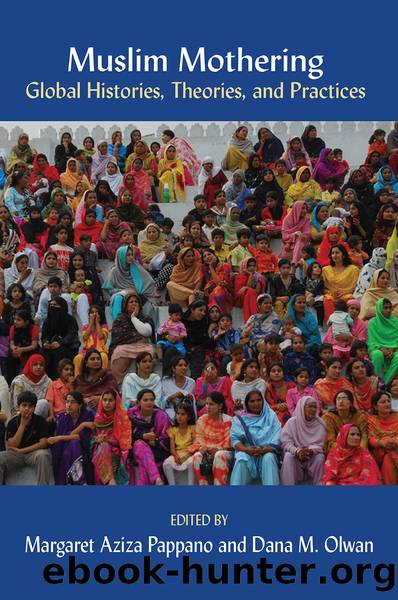Muslim Mothering: Global Histories, Theries and Practises by Pappano M. Aziza;

Author:Pappano, M. Aziza;
Language: eng
Format: epub
Publisher: Demeter Press
Published: 2016-08-15T00:00:00+00:00
III.
MUSLIM MOTHERING IN THE DIASPORA
7.
Muslim, Immigrant, and Francophone in Ontario
A Triple Minoritization or How to See Mothering as an Integrative Process
AURÃLIE LACASSAGNE
THE OBJECTIVE OF THIS CHAPTER is to begin exploring the realities of Francophone immigrant mothers in Sudbury, a bilingual (French and English), mid-sized, northeastern Ontario city. In particular, I seek to uncover the problems and challenges these women may face as they experience their triple minoritization: Muslim, immigrant and Francophone (a minority within the minority within the minority). I also examine whether or not being a mother helps these Muslim women to integrate into a community, in contrast to a traditional perception of motherhood that excludes. (Mothers are said to not have time to enjoy an active social life.) The hypothesis is that mothering and motherhood may prevent the isolation experienced by immigrant and Muslim women. Through in-depth interviews with some Muslim immigrant mothers, I look not only at their experiences of discrimination and racialization, of âothernessâ and âotherization,â but also at the possibility of openness and inclusion that mothering provides to bridge the potential cultural gap between these mothers and the community at large, especially with other Francophone mothers. In the last couple of decades, Sudbury has welcomed an increasing number of immigrants from Muslim backgrounds (apart from a few isolated cases who arrived earlier), yet the numbers are still very low: only a few hundred Muslim women live in Sudbury. Among them, there are some Francophone Muslim mothers arriving with their partners, who are, for the vast majority, students, and, for a handful of them, professionals (education and health sectors). The chapter contends that a common identity based on motherhood could be an element that practitioners working in community and educational organizations could use to build more welcoming communities. In other words, this paper investigates how Muslim and immigrant mothers can unite with other French-speaking mothers to be at the forefront of a truly diversified, multicultural and bilingual community. In the first part of this chapter, I will look at how the triple minoritization context is perceived and experienced by the interviewees. The second part examines the mothering practices of Muslim women and their potential influence on building Sudbury into a more inclusive and welcoming community.
SETTING UP THE CONTEXT: WHAT IS A MUSLIM MOTHER?
Drawing on the reflections of Shahnaz Khan, I take as a point of departure the category âMuslim,â while being aware of the problems associated with that category, in particular its reifying effects. As Khan points out, both Oriental discourses and Islamist discourses âessentialize the ideal Muslim Woman and reduce her to the same symbols and iconsâ (469). The intent of this chapter is not only to avoid this trap but also to showcase the experiences of Muslim mothers who were expressly chosen in this study for their different perceptions, practices, self-identification, and relations to Islam. Most interviewees told me that they were glad to be able to express themselves and their feelings and experiences. Some stated that it was useful, a sort of relief compared to their experiences of isolation.
Download
This site does not store any files on its server. We only index and link to content provided by other sites. Please contact the content providers to delete copyright contents if any and email us, we'll remove relevant links or contents immediately.
| Hadith | History |
| Law | Mecca |
| Muhammed | Quran |
| Rituals & Practice | Shi'ism |
| Sufism | Sunnism |
| Theology | Women in Islam |
The History of Jihad: From Muhammad to ISIS by Spencer Robert(2507)
Nine Parts of Desire by Geraldine Brooks(2281)
The Turkish Psychedelic Explosion by Daniel Spicer(2246)
The First Muslim The Story of Muhammad by Lesley Hazleton(2157)
The Essential Rumi by Coleman Barks(1930)
1453 by Roger Crowley(1881)
The Last Mughal by William Dalrymple(1790)
Trickster Travels: A Sixteenth-Century Muslim Between Worlds by Davis Natalie Zemon(1783)
Muhammad: His Life Based on the Earliest Sources by Martin Lings(1569)
by Christianity & Islam(1562)
God by Aslan Reza(1560)
A Concise History of Sunnis and Shi'is by John McHugo(1510)
Magic and Divination in Early Islam by Emilie Savage-Smith;(1455)
No God But God by Reza Aslan(1436)
The Flight of the Intellectuals by Berman Paul(1396)
Art of Betrayal by Gordon Corera(1365)
Nothing to Envy by Barbara Demick(1326)
What the Qur'an Meant by Garry Wills(1321)
Getting Jesus Right: How Muslims Get Jesus and Islam Wrong by James A Beverley & Craig A Evans(1275)
